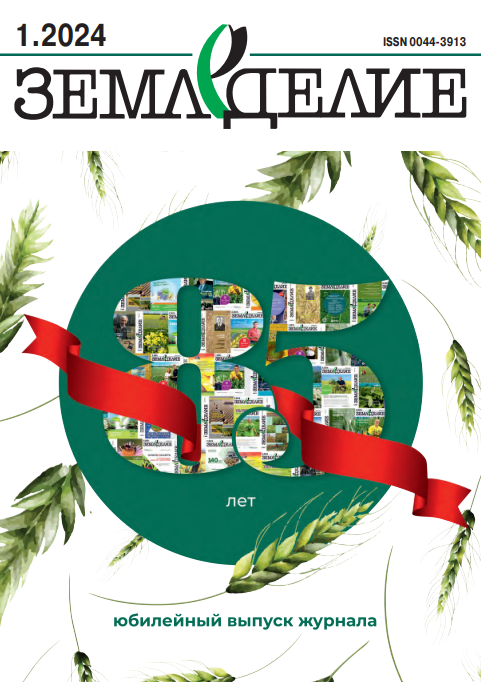Агроэкологические основы химической мелиорации почв
Представлен анализ состояния и динамики кислотности почв сельскохозяйственных угодий, объёмов применения удобрений и мелиорантов за более чем 30 летний период обследования, указаны особенности применения различных форм известьсодержащих материалов и прогноз формирования агрохимических мероприятий на период до 2024 г. Интенсивное подкисление почвенной среды отмечено в последние 10 лет, когда практически полностью прекращены работы по известкованию. Так, по сравнению с 1975–1991 гг., объемы вносимых в Воронежской области известковых материалов снизились в 20…22 раза. Как следствие, теряется до 2/3 урожая сахарной свеклы, что ежегодно оборачивается недобором 352800 т производимого из нее сахара. По данным мониторинга, площади пахотных почв, нуждающихся в известковании, увеличиваются ежегодно на 1 млн га. Наибольшая доля почв, требующих первоочередного известкования, выявлена Центральном (54,9 %) и Северо-Западном (40,6 %) федеральных округах. Ежегодные потери растениеводческой продукции от избыточной кислотности почв в России в пересчете на зерно составляют 16…18 млн т. Впервые высокая эффективность применения известковых удобрений установлена вусловиях Краснодарского края на рисовых полях. Средняя прибавка зерна риса при внесении 3…4 т/га известняковой муки составляла 0,39…0,46 т/га. Рассмотрены факторы, влияющие на эффективность известкования почв, его сочетания с минеральными удобрениями. Установлены количественные параметры миграции оснований из корнеобитаемого слоя почвы в зависимости от гранулометрического состава почв и формы химического мелиоранта. Приведены результаты влияния различных доз извести на урожайность сельскохозяйственных культур. Известкование почв – главное природоохранное мероприятие, обеспечивающее стабилизацию экологической безопасности агроценозов и производство продукции, отвечающей санитарно-гигиеническим нормам. Предложены сценарии проведения химической мелиорации кислых почв в условиях дефицита известковых материалов и финансирования.
Ключевые слова: известкование почв, кальций, магний, плодородие почв, кислотность, урожайность, химическая мелиорация.
Для цитирования: Некрасов Р. В., Овчаренко М. М., Аканова Н. И. Агроэкологические основы химической мелиорации почв // Земледелие. 2019. № 4. С. 3–7. DOI: 10.24411/0044-3913-2019-10401.
Ключевые слова: известкование почв, кальций, магний, плодородие почв, кислотность, урожайность, химическая мелиорация.
Для цитирования: Некрасов Р. В., Овчаренко М. М., Аканова Н. И. Агроэкологические основы химической мелиорации почв // Земледелие. 2019. № 4. С. 3–7. DOI: 10.24411/0044-3913-2019-10401.
Agroecological Foundation of Chemical Amelioration of Soils
R. V. Nekrasov1, M. M. Ovcharenko2, N. I. Akanova3
1Ministry of Agriculture of the Russian Federation, Orlikov per., 1/11, Moskva, 107139, Russian Federation
2Agrochemical Union, ul. Bolshaya Akademicheskaya, 44, k. 2, Moscow, 127550, Russian Federation
3D. N. Pryanishnikov All-Russian Research Institute of Agrochemistry, ul. Pryanishnikova, 31 a, Moskva, 127550, Russian Federation
Abstract. The state and dynamics of soil acidity of agricultural land, the use of fertilizers and ameliorants for more than 30 years of the survey have been analyzed; the application peculiarities of various forms of lime-containing materials and the forecast of agrochemical measures for the period up to 2024 are presented. Intensive acidification of soil has been observed in the last 10 years when liming work has been almost completely terminated. So, in comparison with the period of 1975–1991, the volumes of lime fertilizers applied in the Voronezh region decreased by a factor of 20–22. As a result, up to 2/3 of the sugar beet harvest is lost, which annually turns into a shortage of 352,800 tons of sugar produced from it. According to the monitoring data, the area of arable soil requiring liming increases annually by 1 million hectares. It was revealed that the soil areas requiring immediate liming are the largest in the Far Eastern (59.1%), Central (54.9%), Ural (44.7%) and Northwestern (40.6%) federal districts. The annual loss of crop production from the excess acidity of Russian soil is 16–18 million tons in terms of grain. For the first time, high efficiency of lime fertilizers was established under the conditions of the Krasnodar Krai in rice fields. The average increase in rice grain yield when adding 3–4 t/ha of limestone meal was 0.39– 0.46 t/ha. The factors affecting the efficiency of soil liming, its combination with mineral fertilizers are considered. The quantitative parameters of the base migration from the root layer of soil were established depending on the soil particle size distribution and the form of the chemical ameliorant. The results of the influence of lime’s various doses on crop yields are presented. Soil liming is the main environmental protection measure that ensures the stabilization of the ecological safety of agrocenoses and the obtaining of products that meet sanitary and hygienic standards. Scenarios for the chemical reclamation of acid soils in the context of a shortage of lime materials and funding are proposed.
Keywords: soil liming; calcium; magnesium; soil fertility; acidity; yield; chemical amelioration.
Author Details: R. V. Nekrasov, director of division (e-mail: Адрес электронной почты защищен от спам-ботов. Для просмотра адреса в вашем браузере должен быть включен Javascript.); M. M. Ovcharenko, D. Sc. (Agr.), president (email: Адрес электронной почты защищен от спам-ботов. Для просмотра адреса в вашем браузере должен быть включен Javascript.); N. I. Akanova, D. Sc. (Biol.), head of group (e-mail: Адрес электронной почты защищен от спам-ботов. Для просмотра адреса в вашем браузере должен быть включен Javascript.).
For citation: Nekrasov R. V., Ovcharenko M. M., Akanova N. I. Agroecological Foundation of Chemical Amelioration of Soils. Zemledelie. 2019. No. 4. Pp. 3–7 (in Russ.). DOI: 10.24411/0044-3913-2019-10401.










